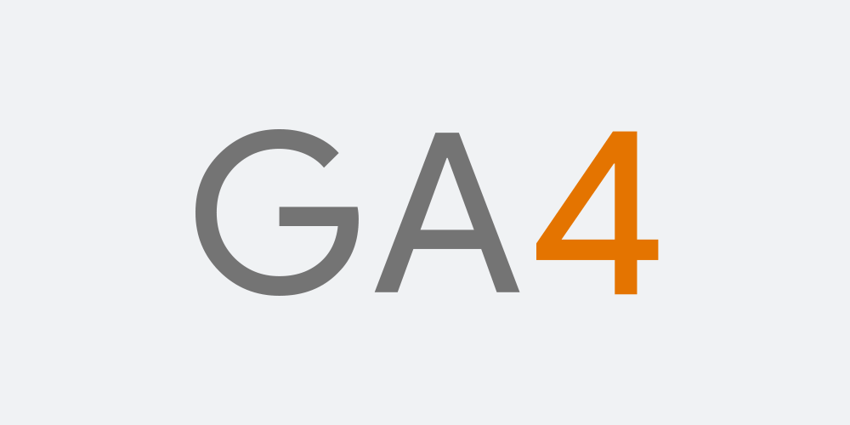Here’s what Google Analytics 4 is, and why it’s critical that you start using GA4 ASAP if you’re not already!
Google Analytics has been around for almost 20 years. Today, it’s by far the most popular analytics tool for websites and apps.
Despite its longstanding popularity and usefulness in the marketing and design spaces, Google Analytics has been undergoing some significant changes recently. Starting this July, every user will officially be making the switch to the new GA4 if they haven’t already.
So what is GA4? And why is Google transitioning away from the reports and features that tens of millions of websites have depended upon for years? In this post, we’re going to clear up those questions and more.
What You Need to Know About Google Analytics 4
Google Analytics 4 lives in the same app as Universal Analytics (the old version of Google Analytics we’ve all been using). While there’s some overlap between the two web analytics tools, GA4 is going to reshape the way we collect, organize, and use data from our digital products.



Here are some answers to common questions and concerns that people have about GA4:
What is GA4?
Google Analytics 4 is an analytics tool that tracks user activity on websites and apps. It is the latest version of Google Analytics. The previous version is referred to as Universal Analytics (or UA).
Website owners, marketers, UX designers, and others can use GA4 to better understand what’s going on with their digital products. What’s more, it can provide valuable insights into users — their demographics, the devices they use, how they discover your digital products, etc.
You can also learn a lot about which content is the most effective at attracting visitors, which content keeps them the most engaged, as well as how effective your product’s conversion strategy is.
While it doesn’t provide a complete picture of your users, their intentions, and motivations, these insights are an invaluable piece of the puzzle.
Is GA4 Replacing Universal Analytics?
Technically, yes. This is a screenshot of my Google Analytics properties as of writing this (March 2023):
Both of these properties point to the same website. However, the top one with the UA- ID number is my old Universal Analytics account. The one at the bottom is my newer GA4 account.
While you can hold onto both types of accounts right now, that won’t be the case starting July 1, 2023. Google has posted noticed about this everywhere, including at the top of users’ existing UA accounts.
Here’s what the notice reads:
“On July 1, 2023, this property will stop processing data. Starting in March 2023, for continued website measurement, migrate your original property settings to a Google Analytics 4 (GA4) property, or they’ll be copied for you to an existing GA4 property, reusing existing site tags.”
Although Google will copy your UA data to a new GA4 account starting in July, it’s better if you do it yourself.
In my next post, I’ll walk you through the process of setting up a GA4 account from-scratch, or migrating your UA account to GA4.
Will Google Analytics Continue to Be Free?
Yes. There aren’t any limitations on who can create a GA4 account or restrictions on which features you can access in the free tool. That said, if you want to up your marketing game, there is a premium version called Google Analytics 360.
Why Is Google Switching to GA4?
GA4 has been in the works for a few years. This next-generation analytics tool was built to address modern challenges in data collection and analysis.
“In today’s measurement landscape, businesses need to navigate new challenges to understand the complex, multi-platform journeys of their customers — all while prioritizing user privacy.”
The restructuring of Google Analytics revolves around those two key factors — the growth of omnichannel marketing and user privacy concerns.
Unlike UA where users had to create different properties for each digital product, GA4 allows them to analyze the unified user journey under one property. And thanks to machine learning and advanced modeling, Google doesn’t need to rely as heavily on tracking pixels to collect user data.
How Does GA4 Differ from Universal Analytics?
The Google Analytics UI hasn’t changed. This is what the UA dashboard looks like:
This is what the Google Analytics 4 dashboard looks like:
It’s the features and functionality of the analytics platform that have changed.
Machine Learning
GA4 takes a machine-learning-based approach to collecting data. This impacts both the quality of omnichannel insights as well as user privacy (the latter I’ll discuss down below).
Users often have to visit digital products multiple times to do their research, vet a brand or product, and eventually convert. With the help of machine learning, Google Analytics has been able to move away from session-specific data which can be inaccurate and lead to duplicate data on users. GA4 now focuses on the journey of individual users across various devices and channels, giving website owners and marketers a better idea of what’s going on.
Machine learning helps in other ways. For instance, GA4 is better able to detect trends in your data and anticipate user actions. As a result, you’re going to receive more helpful recommendations and guidance from Google Analytics going forward.
Lifecycle Tracking
If you compare the navigation of the two GA versions, you’ll notice that it’s been restructured. The various data modules used to be front and center:
- Audience
- Acquisition
- Behavior
- Conversions
While that information still exists in some form in GA4, it’s under Reports now. And the focus now is on user activity throughout the lifecycle of their interactions with the brand as opposed to session-based data per product.
GA4 tracks visitors’ natural progression from prospect to customer with data related to:
- Acquisition
- Engagement
- Monetization
- Retention
This is now possible to do as you can link your GA4 property up to different streams:
Streams can be your website, your mobile (.m) website, as well as your mobile app for iOS and/or Android. With these various products pouring data into a single resource, Google can now better analyze what the entire user lifecycle looks like and give you more accurate and useful data.
Events-based Data
In UA, there was a heavy focus on session-related data. Regardless of which report you looked under, you’d see info about how many sessions there were, how many pages were viewed, how long the sessions lasted, etc.
In GA4, the focus has switched to Events.
In the GA ecosystem, Events refer to important engagements that users make with a digital product. For example:
- Clicking on an interactive element
- Viewing a specific page
- Scrolling to a certain part of a page
- Selecting an item
- Downloading a file
- Logging in
- Beginning the checkout process
- Watching a video
- Using the search bar
You can choose which events are most relevant to your product. You now also have the ability to customize the success parameters of each event.
Once those are configured, your GA4 data will display accurate information within each module about your user activities.
Explorations
Not only does GA4 give you more relevant and useful data about your users, you now have a way to create “explorations” that dive even deeper.
The new Explore tab comes with a variety of templates to start with:
There are different ways to put this feature and templates to use. For instance:
- Compare different types of users (e.g. logged-in users vs. non-logged-in).
- Identify common traits amongst your users.
- Visualize your lead generation or sales funnel.
- See which of your marketing campaigns has been the most successful.
- Evaluate your ecommerce user journey.
This tool allows you to segment the data by pretty much anything you can imagine. If you ever wished Google Analytics would provide you with more specific insights into your users that you could use to improve your content as well as the UX, this tool will be a big help.
Google Ads Integration
You no longer need to go to Google Ads to see your ad-specific data. You also don’t have to view it in isolation. Google Ads has become part of the lifecycle tracking that takes place inside of GA4.
You’ll find it under the new Advertising tab:
With this tool, you’ll be able to see how ad conversions from other channels drive visitors to your site. It’s not just Google Ads or YouTube video ad campaigns that you can track either. You can measure the efficacy of your ads on other paid platforms (like social media) as well as other content from your organic marketing efforts.
You’ll find info on which channels convert the best. You’ll also be able to add filters to compare where those conversions come from — by region, device, etc. In addition, you’ll gain a better understanding of your users’ conversion pathways from your campaigns.
What Are the Benefits of GA4?
Although legacy Google Analytics users have to get accustomed to a whole new approach to website analytics, that’s perhaps the only complaint that can be made of GA4. There isn’t a new interface to get used to nor has the platform been overloaded with unnecessary junk.
GA4 is simultaneously more streamlined and powerful than its predecessor. In addition, users will reap the following benefits:
- AI-powered data acquisition and analysis provides more robust and useful information about your digital products.
- User-centric data helps you create truly user-first digital experiences.
- Multi-channel tracking offers a more accurate picture of who your users are and how they interact with your products.
- Gain enhanced controls over audiences, events, and conversions.
- Create data visualizations that help you learn more about your users and their unique journeys.
- Merge advertising data with website and app user data.
- Implement cookie-less tracking for GDPR and CCPA regulatory compliance.
Google Analytics also remains free to use. So you’re going to get all of these additional features and functionality without any extra costs.
Does GA4 Use Cookies?
I’ve touched on this a couple times already, but let’s unpack what’s going on in terms of GA4 data privacy and compliance with regulations like GDPR and CCPA.
In the past, Google Analytics used cookies to identify sessions and extract information about the users attached to those sessions. But, as Google explains, cookies have become an antiquated (and risky) way to collect data from a website or app:
“Universal Analytics was built for a generation of online measurement that was anchored in the desktop web, independent sessions and more easily observable data from cookies. This measurement methodology is quickly becoming obsolete. Meanwhile, Google Analytics 4 operates across platforms, does not rely exclusively on cookies and uses an event-based data model to deliver user-centric measurement.”
With privacy a priority in Google Analytics 4, Google is moving away from its dependence on cookies. That’s not really new as it had already announced that it would be phasing out third-party cookie tracking in Chrome in 2024.
So, how exactly is Google going to get data from your digital products now?
GA4 uses a combination of first-party cookies (i.e. cookies that users consent to on websites) as well as AI and data modeling. So even if your visitors dismiss that cookie consent notice on your site without accepting the terms, GA4 can still get data via machine learning.
You’ll find an area under your property admin called Reporting Identity.
The new Blended data mode is the one that brings machine learning into the mix. Without this feature enabled, you could be at risk of losing valuable user data if they fail to consent to cookie tracking.
With GA4, you also have the ability to control how deep Google goes when pulling data on your users and then how long it stores it for. You’ll find this under Data Settings.
So in addition to making Google Analytics more compliant with data privacy regulations, it’s also giving you control over how deeply the tool digs into your users.
Where Can You Learn How to Use GA4?
GA4 has been out there since 2020. However, it will become the default and only form of Google Analytics that users can use starting in July 2023.
If you haven’t spent much time getting acquainted with GA4, there are tons of resources out there that can help.
The first place to go is Google documentation:
The most common scenarios and issues that come up have been covered by the very people who built the analytics platform.
I’d also recommend following Google Analytics on YouTube. You’re going to find all kinds of resources and tutorials there to help you master the platform and to maximize your results.
Outside of Google, there are plenty of people taking on the subject of Google Analytics 4. I’d suggest going to your favorite course website and seeing what they have. For instance, sites like CXL and Udemy have some great Google Analytics 4 courses to get you started.
Conclusion
One last thing I will say is that practice makes perfect. While we’ll have more resources on how to get started with Google Analytics 4 and integrating it with your digital products and tools, nothing beats hands-on experience.
So the sooner you can migrate from UA to GA4, the better. Then spend some time playing around with the new features and customizations so you can see first-hand how much more powerful and useful this web analytics tool has become!